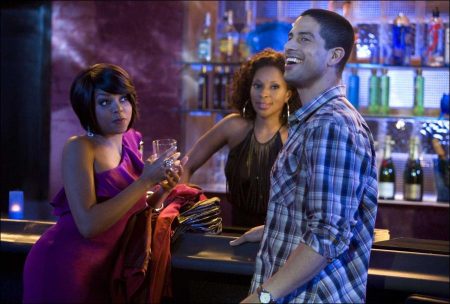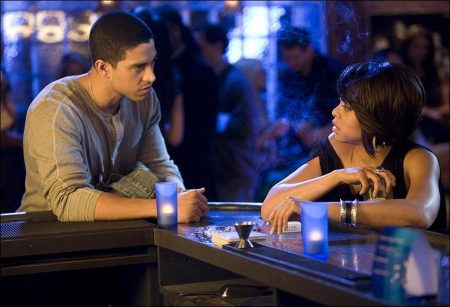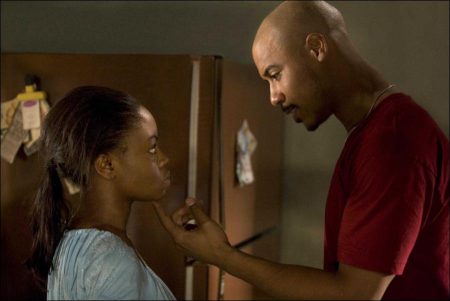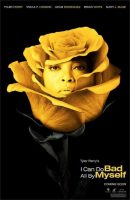Taglines: Hope is closer than you think.
When Madea, America’s favorite pistol-packing grandma, catches sixteen-year-old Jennifer and her two younger brothers looting her home, she decides to take matters into her own hands and delivers the young delinquents to the only relative they have: their aunt April. A heavy-drinking nightclub singer who lives off of Raymond, her married boyfriend, April wants nothing to do with the kids.
But her attitude begins to change when Sandino, a handsome Mexican immigrant looking for work, moves into April’s basement room. Making amends for his own troubled past, Sandino challenges April to open her heart. And April soon realizes she must make the biggest choice of her life: between her old ways with Raymond and the new possibilities of family, faith…and even true love.
With Tyler Perry’s characteristic blend of piousness, mayhem, sass, and kitchen-sink wisdom, I CAN DO BAD ALL BY MYSELF focuses on an essential challenge we all face: learning to love ourselves so that we can give freely and receive love. “We all need to learn to let relationships and communities help us to do good instead of bad, because we can do bad all by ourselves,” explains Perry. Loosely based on his wildly popular stage play of the same name, the film shows that joylessness and a lack of respect for ourselves divorces us from others, and that strong, healthy relationships – both with individuals and a community – elevate us and change our lives for the better.
“The importance of respecting ourselves so that we can truly love others is a message that transcends race, gender, class, and creed,” says Perry’s longtime producer Reuben Cannon. “It’s a major challenge in most of our lives, and this film serves as a funny, soulful, and delightfully musical roadmap for how we can meet that challenge.”
When we meet her, April is doing nothing but bad – by herself, and with the occasional help of her cruel and brutish married boyfriend, Randy. Numbed by alcohol and estranged from her family, April works tirelessly as a singer in a nightclub, sleeps the days away in her dilapidated house and trusts no one. But she’s pushed out of her comfort zone when she’s forced to take care of her teenaged niece and two young nephews and to contend with the attentions of Sandino, a live-in handyman. April clearly longs for true love, but her old habits die hard, and she looks to support from the community, the church, and especially Sandino and the children to help her leave her old, self-destructive life behind.
“April’s a pretty selfish girl,” says Taraji P. Henson, who plays April. “She’s had some hardships in life, and sometimes we choose to let those hardships consume us instead of grow from them. So love is kind of a foreign language to her.”
Known for tackling gritty, risky roles, such as her breakout turn as Shug in Craig Brewer’s HUSTLE AND FLOW, Henson turned heads last year with her performance in David Fincher’s THE CURIOUS CASE OF BENJAMIN BUTTON, which resulted in the actress’ first Oscar® nomination. I CAN DO BAD ALL BY MYSELF film marks the second collaboration between Perry and Henson, who played Pam, Perry’s character’s wife in 2008’s THE FAMILY THAT PREYS.
While April certainly qualifies as another addition to the actress’ stable of hardened, damaged characters, the part presented Henson with a unique opportunity: to show her charisma as a romantic lead. Says Perry, “Everyone knows that Taraji can handle the meatiest of roles. But she doesn’t often get to dress up and show her sexy side, her sophisticated side, her regal side. I have always seen her as not only one of the strongest, but one of the most beautiful actresses of her generation and I was so happy to let her show that off here.”
“Tyler has this great way of thinking out of the box,” adds Henson, “and seeing potential for actors to play against type. What I love about April is that she’s such a multi-dimensional character.” Then she laughs. “And after playing all of these kinds of down-trodden, not too glamorous parts, I finally got a chance to play dress up and be pretty!”
Henson’s co-stars unanimously praise her wholehearted commitment to and passion for acting. Brian White declares that Henson “puts her foot, her heart, her whole essence in every single moment of every single film that she’s ever been in.” And Mary J. Blige echoes, “She’s not afraid to just feel, to go to those places that you think you might get stuck in for the rest of your life.”
While Perry’s films consistently explore issues of relevance to the African-American community, one of the ways he manages to cross cultural boundaries is with his use of music. “Music is a universal way to communicate,” he avows. “It touches all of us, because notes and rhythm speak more to our soul than words alone are able to.”
Gospel music has always been a central part of Perry’s stage plays and his films have all featured brilliant, stirring music. But I CAN DO BAD ALL BY MYSELF goes far beyond simply featuring music on the film’s soundtrack. The characters in the film are musicians who have been transformed and even saved by music; and the songs, which are performed on-screen, are used to reflect every step of April’s emotional journey.
In the film’s opening scene at Club Indigo, April performs a rousing version of “Rock Steady,” written by Aretha Franklin and voiced by Cheryl Pepsii Riley, which demonstrates how music is April’s only escape from the joyless life she’s created. Later, Wilma, played by soul music icon Gladys Knight, tries to communicate a message of self-reliance and self-love to April by performing “The Need To Be,” written by Jim Weatherly. And when April loses her mother, she is forced to confront her sorrow when Mary J. Blige’s Tanya performs the film’s theme, “I Can Do Bad,” which was written by Blige in collaboration with Chuck Harmon and three-time Grammy®-winning R&B star Ne-Yo.
Music in the film gains importance during April’s emotional healing. When she attends a church service for the first time in years at Sandino’s invitation, April is deeply affected by the choir performing an original medley written and sung by Marvin L. Winans and Gladys Knight called, “Just Don’t Wanna Know / Over It Now.” And an emotional turning point comes later when April hears the faint sounds of the same choir singing “Oh, Lord I Want You To Help Me,” performed by Marvin L. Winans and Cheryl Pepsii Riley. April finally commits to her new life at a festive block party, which is anchored by an original song written by Robert F. Aries, Mary J. Blige, Sean Garrett, Freddy Anthony Jackson, and Melissa Joyce Morgan, and performed by Mary J. Blige, called “Good Woman Down.”
In addition to lending their tremendous talents in the form of songs written and performed, Mary J. Blige, Gladys Knight and Marvin L. Winans grace the film with strong, charismatic turns as actors. When it came to casting the part of Tanya, the nightclub owner who is April’s best friend, Perry needed an actress who exudes strength of character, and he knew he had to have none other than Mary J. Blige for the part. “There was no question in my mind that Mary J. Blige was the one who could play Tanya,” he remembers. “She is one of the greatest singers of her generation, and has so much personal strength and presence. I knew how much she had to bring to this part.”
Blige was immediately moved by the parallels between her character’s life and her own. “Music is the thing that saved my life in real life,” she admits. “I could definitely relate to this film, the hard times these characters have seen. I jumped at the chance to play Tanya. It was such an opportunity for me, I wouldn’t have missed it.”
Joining April’s support system is Wilma, a church elder played with gusto by seven-time Grammy winner Gladys Knight. “I’m a lot like Wilma in that I worry about people and their spiritual growth,” explains the singer. “When we stop reaching out, our young people get lost.” Knight touches on a message that has been a quiet constant in Perry’s films and plays: the importance of bridging generation gaps and of youth being taught to respect the wisdom of community elders.
Knight fondly remembers meeting Perry, whose early stage shows she had seen and even owned on tape, years ago when he came to see her long-running show at the Flamingo casino in Las Vegas. “I was jumping up and down,” she says. ” I was trying to be cool, not to let him know how excited I was that he had come.” Although it was years before their schedules created an opportunity for the two to collaborate, they finally did on Perry’s wildly popular TBS sitcom, “House Of Payne.” After that experience, Knight’s participation in the film was a given. “Gladys Knight is a living legend,” says Perry. “It is a pure honor to have been a part of her amazing, recent transition to so much film and television work.”
Renowned Gospel singer Marvin L. Winans also took his first acting turn in the film as Pastor Brian, who teams up with Wilma to help turn April’s life around. “People of strong faith are often able to sense people’s unmet needs and guide them towards fulfillment,” observes Reuben Cannon of the character’s pivotal role. This has proven true in Winan’s real life, where he serves as the founder and Pastor of The Perfecting Church in Detroit, and founded Detroit’s Marvin L. Winans Academy Of Performing Arts, a top rated K-12 charter school that fosters personal growth and learning through the arts.
The mixture of equally accomplished musicians and actors on set led to an atmosphere of mutual admiration and inspiration. “I had to pinch myself on set all the time,” recalls Henson. “I mean, am I really sitting here next to Gladys Knight and Mary J. Blige? It was a bit surreal.” Conversely, both Blige and Knight were in awe of Henson’s talent. “She was amazing,” says Knight. “This is her ballpark, and I respect how at ease she is and how she takes direction.”
In the part of handsome handyman, Sandino, Adam Rodriguez radiates wholesomeness; but the actor is quick to point out that Sandino is more complicated than he initially appears. “He’s come to a place of spirituality and selflessness, but the reality is that he’s still looking for redemption from his own past,” says Rodriguez. “He’s made a lot of mistakes before meeting April.”
“Adam has an ease and a vulnerability that he takes with him anywhere he goes,” says Perry. “It was perfect for this character, who needs to connect so quickly with April and the children. He is so unguarded, as an actor and as a person, that it was absolutely believable that Sandino would disarm April.” “Adam’s not afraid to show his sensitive side,” adds Henson. “It was really beautiful watching him be so vulnerable.”
Brian White’s Randy is the polar opposite of Sandino. An arch villain, Randy drains April of her vitality, disparages her, and has no redeeming qualities. Rather than soft-pedaling Randy’s behavior, White jumps into the role with uncommon fearlessness. “Randy is the lesson learned,” he says. “He’s the kind of guy you don’t want your sisters to bring home. I’ve made his negative characteristics readily identifiable and want to make it crystal clear that these are not qualities or behaviors that are appropriate for men in 2009!”
“Brian is so good at bringing that energy that makes you want to hit him over the head with a bottle!” jokes Mary J. Blige. Henson, meanwhile, found White’s performance so convincing she had trouble distinguishing the actor from the part: “I found myself having to make an adjustment when we would hang out after work,” she admits. “I would have to remind myself to calm down, that this is Brian, not Randy, because he just does such a phenomenal job at it.”
Of course, no discussion of the film’s all-star cast would be complete without the three children, who form the heart of the story and are the cause of April’s transformation. “These kids aren’t playing at acting. They’re the real deal,” Perry avows. “They have fully formed, three-dimensional characters with internal back-stories that they’ve created independently. Every moment of their performances feels real.”
The eldest child and leader of the family is Jennifer, played with uncanny grit by the young theater-trained actress Hope Olaidé Wilson. Like the character she plays, Wilson’s own life is a model of resilience. Of Nigerian descent, Wilson was born in London and raised between Africa and the UK. After immigrating to the United States, her parents worked steadily to overcome poverty and establish a new life for their family. If the film’s message of self-reliance and rising above one’s circumstances appeals to anyone, it appeals to Wilson, whose parents actively instilled those values in her from a young age.
Both Perry and Cannon were stunned by Wilson’s audition. Says Cannon, “Even though so much of the story is universal, hers is such a particularly American character, living in such an American city and family. For her to immediately tap into all of this, given her international background, was something to behold.” After Wilson landed the part, the reality of her achievement didn’t set in until she arrived in Atlanta and began filling out paperwork. She recalls, “I just burst into tears, because I couldn’t believe that it was real.”
While Byron, the middle sibling, is usually silent in the film, Freddy Siglar still manages to make an indelible impression through his facial expressions alone. Often, Siglar would have the cast and crew in stitches between takes. Manny, the youngest brother, is played by child actor Kwesi Boakye. Without fail, the cast describes Boakye as a wise old man inhabiting the body of a nine-year-old. “He feels like someone who has lived all over the world and knows everything. He’s one of the most personable kids you’re ever going to meet,” says Perry.
Like all of Perry’s films, I CAN DO BAD ALL BY MYSELF is distinguished by its eclecticism. Perry’s story combines elements of melodrama, slapstick comedy, romance and inspirational storytelling, while his cast consists of child actors, first-time actors, musicians, and experienced actors playing against type. That these many disparate elements cohere so seamlessly in the film proves Perry’s remarkable talents as a director.
“He’s so smart and off the cuff,” says Henson of her director. “If you’re not hitting a beat, he’ll throw something at you right in the middle of a scene. You can only do your part as an actor if you totally trust the director, and because Tyler is so good at pulling something new out of each actor, something that no one has seen yet, I totally trust him.”
In addition to writing and directing the film, Perry chose to reprise his roles both as Madea and as her riotously inappropriate live-in brother, Joe. Both characters require over four hours of prosthetics, and on days featuring scenes with those parts, the grueling production schedule often demanded that Perry multi-task, directing other actors while in full Madea or Joe make-up and wardrobe.
Despite long hours coupled with a fast production pace, the cast found Perry’s tirelessness and commitment to the project inspiring. Rodriguez recounts how Perry’s example on set made him feel newly committed “to think bigger, dream bigger, work harder.” And Knight adds, “Usually people who fill that many shoes are not good at all of them. He’s amazing at all of them. He’s just fierce. It’s kind of scary to work with a man that skilled!”
Perry’s uncommonly strong work ethic and his uncanny efficiency and resourcefulness are qualities he learned and continues to develop outside the Hollywood studio system. I CAN DO BAD ALL BY MYSELF is the very first feature film shot entirely at Tyler Perry Studios, Perry’s newly opened, 200,000 square foot production facility in Atlanta. Production took place over 25 breakneck days beginning on March 18, 2009, and actually ended earlier than scheduled.
Perry’s crew consistently marvels at how his can-do attitude is absolutely infectious, energizing them in normally daunting situations. One such moment was the production of the film’s climactic block party scene, which was conceived and executed in its entirety in well under 24 hours. The concept had fallen out of the film but was revived in a sudden burst of inspiration and produced – replete with 450 extras, a stage for the band that performs and full wedding costuming for the principle cast members – the same day it was shot. “Tyler firmly believes that where there is a will, there is a way,” says Cannon. “We were so lucky to have found this cast and crew who have the determination and who work together so well to always find a way to bring the vision to life, no matter the constraints.”
Many of the sets were inspired by specific references to Atlanta, where, like most of Perry’s previous films, I CAN DO BAD ALL BY MYSELF is set. It was Atlanta, Perry’s home since 1992, that provided his first, fiercely loyal theater audience, and Perry has been loyal in return, providing over three hundred Atlanta-based jobs through Tyler Perry Studios and Tyler Perry Productions. He has also continued his working relationships with his below-the-line collaborators. Longtime production designer Ina Mayhew, who also had a hand in designing the structures for Tyler Perry Studios, created all the sets for the film, including Club Indigo, April’s house, the church, and the street facade from scratch in a matter of weeks. Co-producer Roger M. Bobb, editor Maysie Hoy, A.C.E., costume designer Keith G. Lewis, music supervisor Joel C. High and composer Aaron Zigman have all worked on the majority of Perry’s films and contribute greatly to Perry’s hyper-efficient schedules.
Through his faith, Perry has overcome well-documented obstacles in his own life, lending credibility to the triumphant storylines in his films. Mary J. Blige attributes his success to his spiritual tenacity. “Tyler is a giver,” she says. “He’s not afraid to share with you what he’s experienced and overcome so that it inspires you. He’s so unselfish, and that’s why I believe he is where he is today.” Knight, being a woman of strong faith, was drawn to his work precisely because of its devotional undercurrents. “Mr. Perry’s movies always show the spiritual solution to every day problems. They call on our desire to be right, to do right,” she says.
In I CAN DO BAD ALL BY MYSELF, April finds community and support through the church, and she finds the courage to turn her life around only by embracing the spiritual faith she had previously abandoned. “April strays from church,” explains Henson. “She strays away from the God in her and the love in her and becomes a very ugly person, and it’s not until she reintroduces herself back to spirituality that she finds love again.”
Piousness in the film, however, is treated with a light hand, as evidenced by a hilarious scene in which Madea recounts a Bible story to Jennifer and botches it completely. Perry explains, “The goal is to make you interested enough in that story to go look it up. If I can make somebody laugh long enough to do that, and then they get engrossed in the real messages, I’ve done my job.” In our troubled current times, Perry and his collaborators believe there’s greater need than ever for messages of love, forgiveness and family that are spiritual at their root, and delivered with humor and levity.
Tyler Perry’s I Can Do Bad All By Myself (2009)
Directed by: Tyler Perry
Starring: Tyler Perry, Taraji P. Henson, Brian White, Hope Olaide Wilson, Adam Rodriguez, Kwesi Nii-Lante Boakye, Frederick Siglar, Gladys Knight, Mary J. Blige, Tess Malis Kincaid
Screenplay by: Tyler Perry
Production Design by: Ina Mayhew
Cinematography by: Alexander Gruszynski
Film Editing by: Maysie Hoy
Costume Design by: Keith G. Lewis
Set Decoration by: Lance Totten
Art Direction by: Mayne Berke
Music by: Aaron Zigman
MPAA Rating: PG-13 for mature thematic material involving a sexual assault on a minor, violence, drug references and smoking.
Distributed by: Lionsgate Films
Release Date: September 11, 2009
Visits: 51






